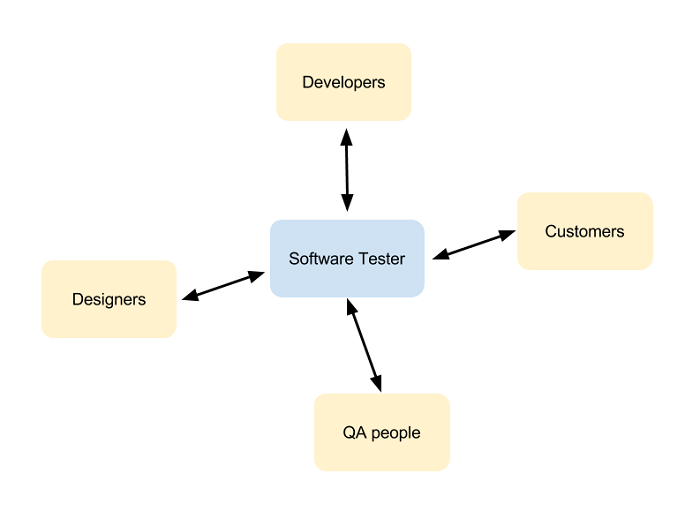Who Is a Software Tester? A Day in the Life of a Software Tester
— August 8, 2016Your software is malfunctioning. It crashes unexpectedly, and the front-end elements fail to perform as intended. These issues can frustrate users and impact the product’s success. When such problems arise, it’s often time to call in a software tester.
Software testers play a pivotal role in software development, ensuring applications are reliable, functional, and user-friendly. Their main job is to identify and report issues to the development team. However, the scope of their work extends beyond just bug detection. This article explores a typical day in the life of a software tester, detailing the critical tasks they handle and the value they bring to a project.
Who Is a Software Tester?
A software tester is a professional tasked with ensuring the quality of software applications. Their primary role is to scrutinize applications, identifying errors, defects, and inconsistencies to enhance software performance and usability. These professionals use systematic testing methods to assess whether a product meets its intended requirements and functions correctly under various conditions.
Software testers contribute to every stage of the software lifecycle. They collaborate with developers, project managers, and other stakeholders to understand the application’s objectives and technical specifications. Their insights ensure that every feature, from basic functionality to advanced integrations, works seamlessly.

Testers employ several types of testing to evaluate software:
- Functional Testing: This involves verifying that the software operates as intended by checking each feature against specified requirements.
- Non-Functional Testing: This type focuses on performance, security, and usability, ensuring the software performs well under stress and offers a secure, intuitive user experience.
- Unit Testing: Testers examine individual components or modules of the software to confirm they function correctly in isolation.
- Integration Testing: This stage assesses how different software components interact, ensuring they work harmoniously when combined.
- System Testing: Here, the entire software is tested as a unified system to identify any overarching issues or inconsistencies.
- Acceptance Testing: Conducted with end-users or representatives, this testing determines if the software meets their needs and expectations.
A software tester’s efforts directly impact the product’s success. By ensuring that applications are bug-free and meet user demands, they contribute to delivering high-quality software that stands out in a competitive market.
The Importance of Software Testers
Software testers are indispensable in modern software development. Their role goes beyond merely finding bugs; they help shape the software to meet user expectations and market demands. Without thorough testing, even the most innovative applications risk failure due to flaws that could have been prevented.
Testers act as the final line of defense before software reaches users. They ensure that every feature performs as intended, minimizing the risk of crashes, data breaches, or user dissatisfaction. This quality assurance not only enhances the product’s reputation but also saves businesses from potential losses due to negative reviews or support costs.
For companies in competitive industries, especially those leveraging outsourcing in countries like Vietnam, having skilled testers is vital. Their expertise ensures that the software is robust, secure, and capable of competing in the global market.
A Typical Day in the Life of a Tester
The day of a software tester begins with preparation and planning. Testers often start by reviewing the tasks assigned to them, understanding the test cases they need to execute, and setting priorities based on project deadlines.
One of the first activities in a tester’s day is attending a stand-up meeting with the development team. These meetings allow testers to discuss the current status of the project, highlight any challenges, and coordinate with developers on resolving identified issues. This collaboration ensures alignment between the testing process and development objectives.
After the meeting, testers dive into the technical work. They execute test cases designed during the planning phase, systematically evaluating different parts of the software. If they encounter bugs, they document the issue in detail, noting the conditions under which it occurred, the steps to reproduce it, and any potential implications. This detailed documentation helps developers understand and address the problem efficiently.
Testers also engage in exploratory testing, going beyond predefined scenarios to uncover hidden issues. This approach often reveals bugs that traditional testing might miss, adding an extra layer of assurance to the software’s quality.
Depending on the project phase, testers might also focus on automation. Automated testing tools enable testers to run repetitive tests quickly and accurately, freeing up time for more complex tasks. Automation plays a crucial role in ensuring consistent results, especially in large-scale or long-term projects.
Finally, a significant part of a tester’s day involves reporting. After executing tests, they compile detailed reports summarizing their findings, including the number and severity of bugs identified, test coverage achieved, and areas that require further attention. These reports serve as a valuable resource for developers, project managers, and stakeholders, ensuring informed decision-making throughout the software development process.
The Secret Life of a Software Tester: More Than Just Clicking Buttons
Bugs All Day Long
Software testers play a critical role in ensuring the stability and functionality of software. Despite the expertise of developers and the time dedicated to quality assurance, bugs inevitably find their way into applications. It becomes the responsibility of software testers to identify these issues and report them effectively.
The primary job of a software tester involves locating and documenting bugs. This task is not limited to simply noting their existence but extends to providing detailed reports that developers can use to fix the problem. Testers must revisit these bugs after developers address them to ensure the fixes are thorough and effective.
One challenge in this process is the coordination between testers and developers. Some bugs may not be resolved immediately, requiring additional information or clarification from testers. This back-and-forth exchange demands persistence and clear communication. However, the most challenging aspect of this job lies in dealing with bugs that testers miss. When end users discover these issues, it reflects a gap in the testing process, prompting testers to revisit their methods and improve their approach.
Missed bugs can damage a company’s reputation, making this aspect of the tester’s role particularly critical. Testers must continuously refine their skills, adapt to new tools, and implement best practices to minimize such occurrences.
Coordinating Between Departments
Coordination is a significant part of a software tester’s daily routine. When a tester discovers that a previously reported bug remains unresolved, they must document the issue again and investigate the reasons behind the delay. This process involves close collaboration with developers, project managers, designers, and sometimes even clients.
A tester ensures developers have all the necessary details to fix errors effectively. They also communicate user feedback to designers, aligning software improvements with user expectations. Furthermore, testers often bridge the gap between customer needs and company strategies, ensuring that the product meets both requirements.
This level of coordination requires excellent organizational and interpersonal skills. Software testers must manage multiple tasks, balance priorities, and ensure all stakeholders are informed and aligned. Effective communication is essential to avoid misunderstandings and ensure smooth workflows.
Project Updates
Each day for a software tester typically begins with reviewing project updates. Testers check emails and project management tools for updates from project managers and developers. These updates often include instructions for new test cases or information about the status of previously reported bugs.
Understanding these updates allows testers to adjust their tasks for the day. If new priorities emerge, they must quickly adapt their plans. Change requests, while often disruptive, are a common aspect of software testing. Testers must embrace these changes as part of their role and handle them efficiently.
By staying informed about project developments, testers can ensure their efforts align with overall project goals. This proactive approach minimizes delays and helps maintain the quality of the software.
Testing, Testing, Testing
After addressing organizational and communication tasks, a software tester begins their primary responsibility: TESTING. The order of tasks often depends on the priority of test cases. For example, a test case related to a feature scheduled for immediate release takes precedence.
Consider a scenario involving a search bar on a website. If this feature is set to go live within a few hours, the tester must ensure its functionality without delay. This involves a series of checks, from verifying that the search yields accurate results to confirming the interface’s responsiveness.
The testing process often requires multiple iterations. A tester may report an issue, only for the developer to request additional clarification or suggest changes. Each interaction requires the tester to understand the developer’s feedback thoroughly to refine their testing approach.
Some test tickets involve a sequence of smaller tests, each targeting specific aspects of a feature. This granular approach helps identify potential issues early and ensures comprehensive coverage of the software’s functionality.
Test Planning
Effective test planning is crucial for a software tester’s success. Planning involves setting clear objectives, defining the scope of testing, and allocating resources. A test plan outlines what features will be tested, the methodologies to be used, and the criteria for determining when testing is complete.
For instance, a tester may create a plan for an upcoming feature release, specifying the test cases required to validate functionality, performance, and security. The plan also identifies potential risks and assigns roles to team members.
Test planning not only provides structure but also helps testing teams stay focused and organized. By anticipating challenges and preparing solutions in advance, testers can execute their tasks more efficiently.
Test Reporting
Reporting is a vital aspect of a software tester’s role. Beyond identifying bugs, testers must communicate their findings to stakeholders. This involves documenting what was tested, the results of the tests, and any critical issues that require immediate attention.
For example, if a tester discovers a flaw in a mobile app’s payment system, they must provide detailed information about the issue’s impact on users and suggest potential solutions. Clear and timely reporting enables management to make informed decisions and prioritize fixes.
Daily reports often include updates on completed tests, pending tasks, and any roadblocks hindering progress. These reports help keep projects on track and ensure that all team members are aware of the current status.
Wrapping It Up
The role of a software tester is dynamic and challenging. Each day presents new tasks and obstacles, requiring a blend of technical expertise, problem-solving skills, and effective communication. From identifying bugs to coordinating with teams and planning future tests, every activity contributes to the overall quality of the software.
By excelling in these tasks, software testers play a pivotal role in delivering reliable and user-friendly applications. Their efforts ensure that software meets customer expectations and performs seamlessly in real-world scenarios.
About S3Corp
S3Corp is a leading software outsourcing company in Vietnam, specializing in delivering high-quality software solutions. With over 18 years of experience in the industry, S3Corp. provides end-to-end services, including software development, web application development, mobile application development, product verification, and quality assurance.
With many years working in software outsourcing vietnam, our team of professional testers is dedicated to delivering high-quality software solutions and ensuring the success of its projects. S3Corp’s commitment to quality has made it a trusted partner for businesses seeking reliable outsourcing solutions. By following industry best practices and leveraging advanced testing tools, S3Corp ensures that its clients receive software products that meet the highest standards.






